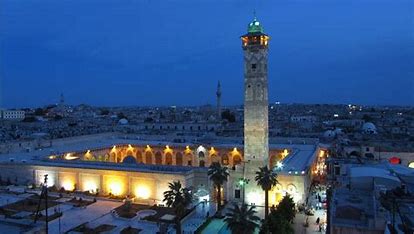Al-Walid ibn Abd al-Malik laid the foundation of the mosque upon the ruins of a Byzantine cathedral, transforming it into a center for the propagation of monotheism throughout the northern Levant.
During the Seljuk era, the original wooden columns were replaced with black basalt ones, and a soaring minaret—45 meters tall—was added, featuring unique geometric ornamentation reminiscent of the art of Mosul.
In 1090 CE, the governor of Aleppo, Radhwan the Seljuk, ordered the expansion of the arcades and the inlaying of the mihrabs with mother-of-pearl and ivory. Colored tiles were introduced to reflect the light of a marble courtyard that cooled the scorching Aleppo summer. The mosque remained an academic hub, producing renowned scholars such as al-Qurtubi and al-Nawawi alongside countless other students.
The mosque was besieged in 2012, and the adjacent city market was set ablaze; then, in 2013, the minaret collapsed under bombardment, leaving a devastating void in Aleppo’s skyline.
In collaboration with Czech engineers, the Directorate General of Antiquities cataloged 2,350 foundational stone blocks and replaced the missing pieces with matching Shihani stone, allowing the minaret to be rebuilt in October 2023.
The new visitor route explains the acoustic engineering of the arcades—designed to amplify the call to prayer—while the olive gardens surrounding the courtyard restore the site’s link to the fertile environs of the Euphrates.















